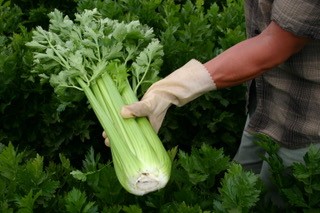Darrell Beyer, the organic sales manager for Boskovich Farms Inc., Oxnard, CA, was quoting $74 for a carton of celery this week. And he could have gone higher.
“Some people are quoting higher and getting it, but how high do you want to go,” he asked. “They (buyers) are going to remember it; you don’t want to be a jerk.”

Darrell Beyer, organic sales manager, Boskovich Farms Inc.
A celery juicing craze touted by some health advocates and celebrities has been cited as a potential reason for the celery shortage. Steve Adlesh of Beachside Produce in Guadalupe, CA, believes the juicing phenomenon deserves some of the credit. He said industrial juicers buy a lot of celery and so do the home juicers. “Have you seen the number of juices that are now sold in the supermarket next to the produce department,” he said. “It’s amazing. There is a lot of celery used for that.”
Beyer isn’t so certain; he thinks it is more likely a case of fewer plantings leading to fewer stalks of celery. He said the previous high point that he can remember for celery was $50 per carton several years ago. Looking down the road – at empty fields everywhere – Beyer does not expect the supply of organic celery to even come close to the demand for several months. “It’s going to be July,” he said. “There are hundreds and hundreds and hundreds of acres out there that have yet to be planted.”
He wasn’t just talking about organic celery but rather was speaking of the impact the rains in California have had on the planting of crops during the first quarter of the year. The coastal production areas from Oxnard to Watsonville have had steady rain with standing water being reported in some fields for 10 days or longer. “We’ve tried to hand plant (our organic fields) and work around the rain,” Beyer said, “but there are problems everywhere.”
Steve Adlesh, Beachside Produce
It’s just a matter of the math. It takes crops from 40 to 90 days to grow when planted in the cold winter months. As the temperature warms up, those growth cycles are shorter but they are still long enough that it is close to impossible to make it up when you lose a week or longer of planting time. Speaking of the entire organic vegetable production, Beyer said “we are going to see big fluctuations between now and July. Monday, kale might be $24; Friday, it could be $16 and then back to $24 again on Monday.”
He said the roller coaster rides are going to be caused by these gaps in plantings, followed by a bunching up of supplies as growers had to double plant in between storms to fill their fields. Beyer said only green onions were currently in a situation where they might be promoted. He said there are literally no organic vegetable crops that will not have an inconsistent supply during the next month or two. He said in theory, the fastest-growing crops such as spinach – which can be as little as 30 days from planting to harvest – could be up and running more quickly.

Others reported the same news about upcoming lack of supplies. In its March 31 “Market Update”, the Nunes Company revealed that most of the organic crops would be transitioning from their desert district to the Salinas Valley beginning April 8 and continuing for at least two weeks. The report said for organic buyers to “expect market volatility on all commodities through the end of the Yuma deal and into April.”






